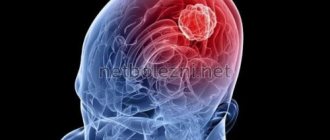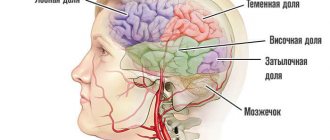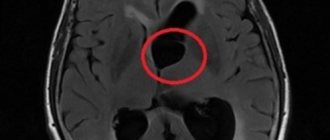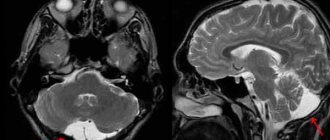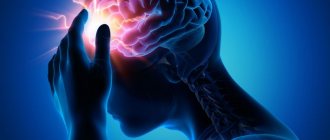Brain cancer is a process of pathological transformation of brain cells or the surrounding meningeal, glandular and bone tissues. As a result of transformation, abnormal cells begin the process of uncontrolled division, which causes the formation of a tumor that compresses healthy tissue and increases intracranial pressure. In conditions of limited space in the cranium, even a benign neoplasm, if left untreated, can lead to disability or even death.
Kinds
Brain tumors are divided into:
- primary – developing directly from intracranial tissues;
- secondary – developing from metastases spread by a tumor located in another organ.
Tumors are classified according to the location of their formation:
- neuroepithelial, or gliomas – appearing directly in the brain tissue;
- meningiomas - developing in the tissues of the membranes of the brain;
- neuromas – originating in the cells of the nerve fibers of the skull;
- pituitary adenomas – rarely showing malignant signs;
- metastases from other organs;
- dysembryogenetic neoplasms that develop during the embryonic period of a child’s development.
What are the types of malignant brain tumors?
The most common brain tumors are gliomas and meningiomas. The first group develops from brain tissue, the second - from the membranes of the brain. Most meningiomas are benign, and only 1% are meningiomas of the third, highest grade of malignancy. At the same time, most gliomas are malignant.
The most common tumor of this type is glioblastoma. For gliomas, there are 4 degrees of malignancy of neoplasms, and glioblastoma has the fourth, highest degree. The problem with treating it is that it is often located deep in the brain and is difficult to reach. In addition, the tumor does not have a clear boundary: it grows into the surrounding healthy tissue.
Even the most aggressive neoplasms usually do not metastasize beyond the central nervous system. But they spread within the brain, and as they grow, they destroy surrounding healthy tissue.
In practice, a neurosurgeon who operates on adult patients most often has to deal with glioblastoma or metastatic cancer tumors of other localizations among all malignant neoplasms. Most other formations are very rare or benign in nature.
9500 patients annually
- We accept patients 24/7
- Stabilization, resuscitation, medical care
Call me back!
Symptoms
When brain cancer appears, symptoms in the early stages are local and depend on the location of the tumor. The disease manifests itself:
- impaired sensitivity in certain parts of the body, deterioration of orientation in space;
- memory impairment;
- decreased muscle activity up to complete paralysis;
- convulsive seizures of an epileptic nature;
- hearing damage and decreased speech recognition function;
- partial or complete visual dysfunction;
- partial or complete loss of the ability to write and speak;
- weakness, fatigue;
- pathological changes in the production of hormones from the pituitary gland or hypothalamus;
- changes in character, emotional imbalance;
- decrease in intellectual level;
- the appearance of hallucinations.
The first signs of brain cancer appear as minor changes in one or more of these areas, but the deterioration progresses over time. With a significant increase in pressure inside the skull, general cerebral symptoms appear:
- persistent headaches of high intensity that cannot be relieved with analgesics;
- dizziness caused by compression of the cerebellum or decreased blood supply to brain structures;
- vomiting independent of food intake.
Head and Neck Cancer: Symptoms and Signs
Patients with head and neck cancer often experience the following symptoms or signs. Sometimes patients with head and neck cancer do not experience any of the following changes. Or the cause of the symptom may be a non-cancer disease.
- Non-healing inflammation or wound
- Red or white spot in the mouth
- Lump, lump, or mass in the head or neck area, painful or painless
- Long-lasting sore throat
- Putrid odor from the mouth that cannot be explained by hygiene
- Hoarseness or hoarseness of voice
- Frequent nosebleeds and/or unusual nasal discharge
- Difficulty breathing (including nasal breathing)
- Double vision
- Numbness in the neck or weakness in the occipital region
- Pain or difficulty chewing or swallowing even small pieces of food
- Jaw pain
- Bloody discharge in saliva or phlegm, mucus that is secreted into the mouth from the respiratory tract
- Loose teeth
- Dentures that no longer fit
- Unexplained weight loss
- Fatigue
- Ear pain or infection
If you are concerned about any of the above, you should contact a specialist. Your doctor will ask, among other things, how long and how often you have been experiencing the symptom(s). This conversation will help in making the correct diagnosis.
Once cancer is diagnosed, symptom relief remains an important part of cancer care. This may be called palliative or supportive care. It often begins soon after diagnosis and continues throughout treatment.
Causes and risk factors
The exact causes of brain cancer are still unclear, but there are certain risk factors that significantly increase the likelihood of developing tumors:
- predisposition inherited from parents or other close relatives;
- work in hazardous production;
- long-term exposure to radiation;
- decreased immune system function;
- infection with Epstein-Barr virus or cytomegalovirus;
- past traumatic brain injury;
- male gender, old age, white race.
The presence of one or even several of the listed signs does not mean that a person will necessarily develop a tumor in the brain, but the risk of developing the disease for these people is increased compared to others.
Stages
Since signs of brain cancer do not appear immediately after the onset of the disease and remain subtle for a long time, accurately determining the stage of tumor development is a rather difficult task. Oncologists distinguish four stages of the disease.
- Pathological changes affect a small number of cells localized in a limited area of the brain. The patient experiences periodic headaches, weakness, constant drowsiness, and dizziness often occurs.
- The tumor grows, penetrates nearby tissues, and begins to compress individual centers of the brain. This can be manifested by convulsive attacks, periodic vomiting, and digestive disorders.
- Due to the rapid growth of the tumor, surgical removal of malignant tissue becomes almost impossible. Symptoms intensify, cognitive impairment appears, and coordination of movements worsens. A characteristic symptom of the third stage is horizontal nystagmus, or constant horizontal movement of the pupils.
- The tumor grows so much that the patient experiences constant headaches and gradually loses the functions of maintaining vital processes. In the absence of treatment or its low effectiveness, the patient falls into a coma, followed by death.
Pathogenesis
With any tumor, the defining feature is cell proliferation that gets out of control. The cause of this reproduction is an oncogene. Cell proliferation, invasive growth and the immune response of cells are interrelated, but are independent processes associated with genetic changes. Thus, the TSC-22 gene has been studied, which is important in various malignant brain tumors. In brain gliomas, the metabolism of non-heme iron is important.
Changing the cell genome activates antitumor immunity. However, the immune system also contributes to tumor progression by producing an immunogenic tumor phenotype.
As the tumor grows, the following occurs:
- its invasion into surrounding tissues and their destruction;
- compression of underlying tissues;
- increased intracranial pressure;
- cerebral edema;
- difficulty in the outflow of cerebrospinal fluid;
- the growth of new vessels in the tumor, becoming a source of bleeding;
- disturbance of venous and arterial blood flow.
Diagnostics
It is difficult to determine the presence of a brain tumor based on symptoms, especially in the early stages. Taking a biopsy specimen for histological examination is very difficult, since this requires a full-fledged neurosurgical operation. During the examination, the neurologist prescribes the following types of diagnostics:
- electroencephalography to detect brain disorders;
- Echo-EEG to check intracranial pressure;
- ophthalmoscopy to exclude deterioration of visual function due to ocular pathologies;
- CT scan of the brain is the main study that allows you to detect a tumor, determine its size, the presence of hemorrhages, calcifications and other pathological changes in tissues;
- MRI of the brain is a complementary study to CT, necessary to clarify changes in the soft tissues of the brain;
- MRI of the vessels of the head - to study changes in the structure of the blood supply to the brain and other tissues;
- PET scan of the brain - to determine the level of malignancy of the tumor.
If a decision is made to perform surgery, a histological examination of the removed tumor tissue is required to determine the histological type of tumor and the level of cell differentiation.
Attention!
You can receive free medical care at JSC “Medicine” (clinic of Academician Roitberg) under the program of State guarantees of compulsory medical insurance (Compulsory health insurance) and high-tech medical care.
To find out more, please call +7, or you can read more details here...
Procedures and operations
Brain cancer is a serious disease and tumor removal is important to perform accurately, so a neuronavigation system is used during the operation. Before surgery, the patient’s research data is entered into the navigation system program, and a 3D computer model of the brain with tumors and blood vessels is obtained, which helps virtually plan the operation. Surgical treatment is based on the principle: extracerebral tumors are removed completely, and intracerebral tumors are removed as much as possible, so that brain function does not suffer. Any operation should involve minimal trauma, preservation of brain structures, blood vessels and veins. Some areas of the brain are considered inoperable - these are the motor and speech areas.
Minimally invasive surgery to remove a tumor is performed using laser, stereotactic and endoscopic techniques. Minimally invasive operations are performed through endonasal access (through the nostril), supraorbital (through an incision above the eyebrows), retrosigmoid (incision behind the ear), as well as through any point convenient for removing deep-lying tumors. Minimally invasive approaches are as effective as invasive ones. If the operation is performed on functionally significant areas, then laser technologies are used. This could be laser thermal destruction. For deep-lying tumors, brachytherapy and photodynamic therapy are used to destroy them.
Highly effective technologies allow treatment without surgery. These include radiosurgery methods: linear accelerator, gamma knife. However, they can be used for small lesions.
Gamma Knife is a form of radiation therapy. This ultra-precise method destroys even several formations per session. The method is applicable for multiple lesions (tumors of metastatic origin). The CyberKnife system is equipment based on a linear accelerator that delivers high doses to the tumor and destroys it. The operation does not require open intervention. If the tumor is large, the bulk of the tumor is first surgically removed, and then irradiation with the CyberKnife system is used.
Boron-neutron capture therapy method. With this method of exposure, the destruction of a tumor that has accumulated the boron-10 isotope is carried out by neutron irradiation. Boron accumulated in cells increases sensitivity to radiation. Boron isotopes absorb neutrons and a “nuclear” reaction occurs, during which energy is released that destroys the new formation. Brachytherapy has not become widespread. It is carried out by implanting radioactive sources (iridium-192, iodine-125, palladium-103) into the tumor tissue.
Before the operation, the possibility of its implementation and safety are taken into account. Without these predictions, surgical treatment is considered inappropriate. With any type of intervention, consequences are possible in the form of disturbances in movement, speech, hearing, vision, reading, and mental changes. It all depends on the location of the tumor and the degree of trauma to surrounding tissues. When a pituitary tumor is removed, hormonal function is disrupted. Motor disturbances that occur immediately after surgery are associated with cerebral edema. But with the use of decongestants, patients recover quickly.
Treatment
Regarding the treatment of brain oncology, you should contact a neurologist or neurosurgeon. Based on the stage of development and location of the tumor, the doctor selects the most appropriate treatment methods in each case.
- Neurosurgery. Removal of a malignant neoplasm is the most effective way to guarantee complete relief from the disease. Intervention is possible at the first and partially at the second stage of the disease, but much depends on the location of the tumor and its proximity to vital centers of the brain. The efficiency of surgeons has increased thanks to the use of laser and ultrasound technology.
- Radiation therapy. Removal of malignant cells using ionized radiation is used as an auxiliary means after surgery, and also as a main means in cases where intervention is not possible. The intensity and duration of irradiation in each case is selected individually, in accordance with the size and location of the pathological area, the type of altered cells and other characteristics.
- Chemotherapy. It is difficult to select drugs for the treatment of brain tumors due to the presence of the blood-brain barrier. As a rule, they are prescribed in combination with radiation therapy, and the course consists of several drugs that complement each other. Courses lasting 1-3 weeks are carried out under constant monitoring of blood changes.
- Cryosurgery. The destruction of tumor tissue by freezing is beneficial in cases where traditional surgery is difficult due to the proximity of vital centers or the deep location of the pathological area. Cryosurgery can be used as a primary method or as an adjunct to conventional surgery, laser and chemical treatments.
- Symptomatic treatment. If the tumor is detected too late, and any of the listed methods do not achieve results, the patient is prescribed therapy aimed at reducing symptoms and improving quality of life. These are glucocorticosteroids, sedatives and antiemetics, NSAIDs for pain relief, as well as narcotic analgesics.
REHABILITATION OF PATIENTS
THE RUSSIAN - JAPANESE ONCOLOGICAL CENTER HAS DEVELOPED REHABILITATION PROGRAMS FOR PATIENTS AFTER TREATMENT, CHEMOTHERAPY AND RADIATION THERAPY.
Rehabilitation is aimed at areas of the brain that are responsible for important body functions: speech, movement, sensory organs, thinking, memory.
With rehabilitation treatment, the risk of complications after chemotherapy is reduced to a minimum. The patient does not experience severe symptoms after the procedures and does not lose quality of life.
Feel the quality of life after rehabilitation!
The patient should never forget that brain cancer is an aggressive type of cancer and develops quite quickly. Relapses are possible, so we make sure to monitor our patients at least 2 times a year and repeat the supporting set of rehabilitation measures after a year or a year and a half.
Our experience shows that treatment of brain cancer is always possible, even regardless of its stage and location.
The developed and tested methods of our Oncology Center are aimed at curing this disease, reducing its symptoms, preventing the progression of the disease and improving the quality of life!
Forecasts
The success of treatment depends on the timely detection of the disease. If therapy is started at the first or second stage of brain cancer, the five-year survival rate is, according to various estimates, 80-85% of patients. If the disease is detected late, a favorable outcome is possible for approximately 31% of patients. However, it should be remembered that cancer is one of the least studied areas of medicine, so you should never give up your chances of life, even in the most advanced cases of the disease.
Questions and answers
How do you know if you have brain cancer?
In the initial stages of the disease, symptoms of brain cancer can easily be confused with signs of ordinary fatigue, a mild cold, or a neurological or cardiac disease. To be sure that there is no disease, it is necessary to undergo a CT scan, which allows you to detect a tumor in the initial phase of development.
Is there a cure for brain cancer?
With timely detection of a tumor, timely and high-quality surgical treatment, one hundred percent restoration of health is possible.
What causes brain cancer?
A tumor in the brain tissue develops because one or more cells begin the process of abnormal division. In this case, the pathologically altered cells lose their original function and are only capable of rapid division, which is why the size of the tumor grows rapidly. It has not yet been possible to establish what mechanisms trigger this process.
Attention! You can cure this disease for free and receive medical care at JSC "Medicine" (clinic of Academician Roitberg) under the State Guarantees program of Compulsory Medical Insurance (Compulsory Medical Insurance) and High-Tech Medical Care. To find out more, please call +7(495) 775-73-60, or on the VMP page for compulsory medical insurance
Signs in women
The first signs of a brain tumor in women are similar to those observed in men. Therefore, there is no need to talk about specific signs of the development of tumors in women.
Signs often repeat those of other pathological conditions, for example, headache, tinnitus, decreased vision, nausea and others.
However, symptoms that last a long time (several weeks) and are persistent, increasing in nature, indicate the occurrence of tumor processes.
Therefore, it is important to seek medical help as early as possible. This will allow diagnosis and effective treatment methods to be applied.
